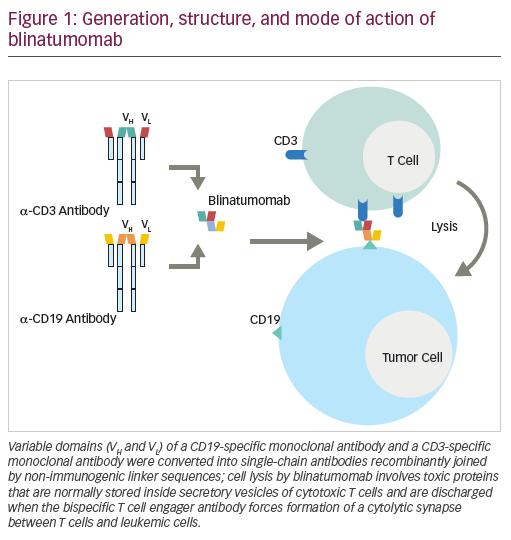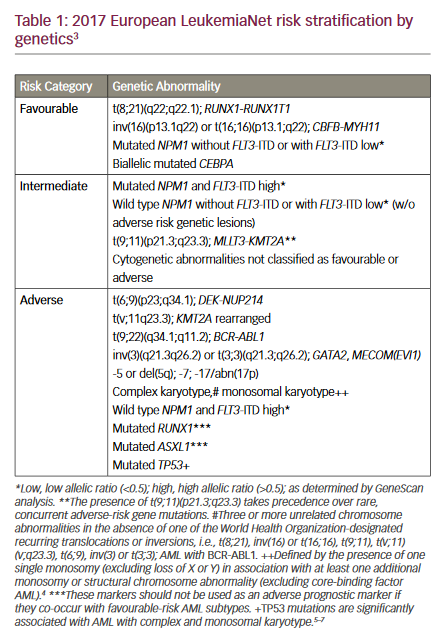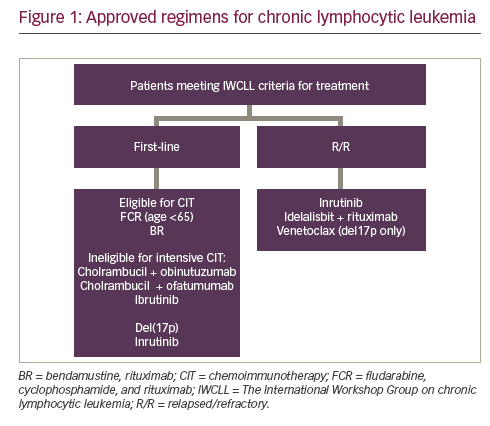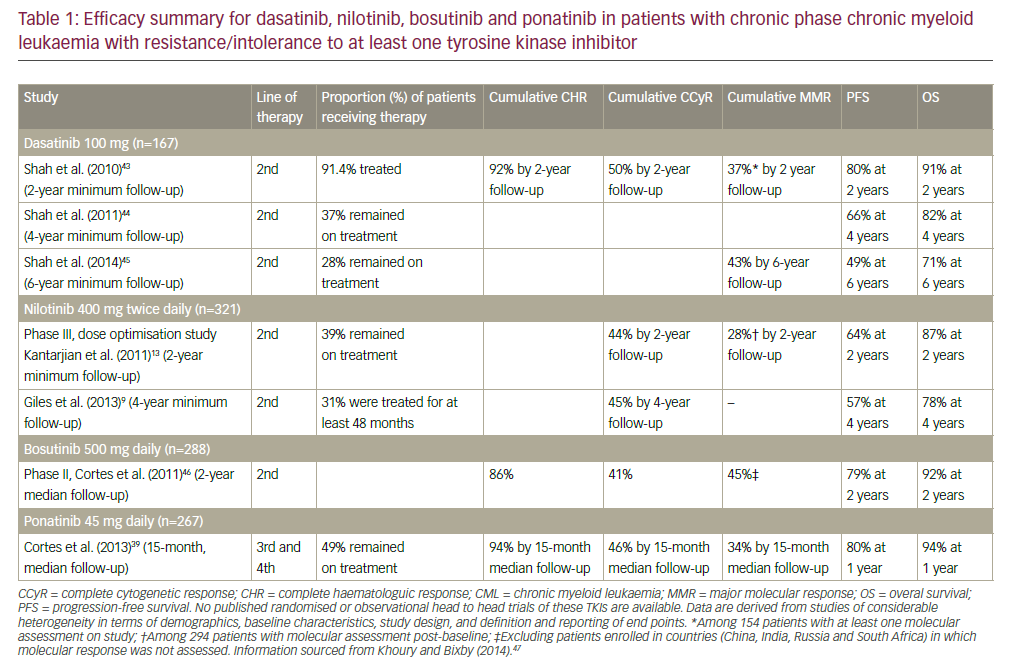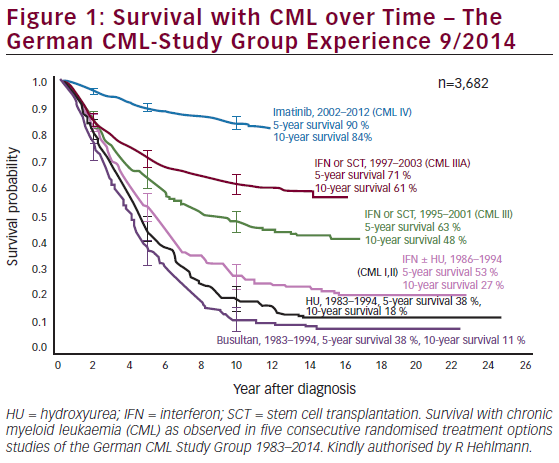As the development of BCR-ABL1 targeting treatments has continued, patients with chronic phase chronic myeloid leukaemia (CML‑CP) were shown to have similar survival rates in all age groups to that of general population in the era of tyrosine kinase inhibitors (TKIs).1 First, imatinib and subsequently the second-generation TKIs (2GTKIs) (nilotinib and dasatinib) revolutionised the treatment of CML, and most patients live longer with usually improved quality of life than those treated before the era of TKIs. Currently TKIs are the mainstay of CML treatment, but some patients need additional treatment modalities due to resistance and intolerance to TKIs, and allogeneic haematopoietic stem cell transplantation (alloHSCT) is still a treatment option in selected cases. In addition, in most of the emerging nations where governments cannot afford the budget for the TKIs, physicians treating CML in these countries are advocating frontline alloHSCT. Also the high cost of new cancer drugs including those developed for CML is a major concern for healthcare payers,2 especially in countries with restricted resources, so the governments most probably will have difficulties in affording the expenses of the original TKIs in the near future. In order to overcome this matter, generic imatinibs were introduced in the treatment of CML in many countries in the recent years.3
In this issue of European Oncology & Haematology, Carella and colleagues evaluated the current situation of CML treatment and they also overviewed the future perspectives for ‘curing’ CML.4
Before the era of TKIs, CML therapy mainly consisted of hydroxyurea, busulphan, cytosine arabinoside and interferon-alpha (IFN-α). alloHSCT was the only modality to achieve long-term remission or cure in CML patients with good performance status and an available donor. Since the prospective, multicentre, open-label, phase III, randomised study –the International Randomized Study of Interferon and STI571 (IRIS) trial,5 the natural history of CML significantly changed, and 10-year overall survival (OS) significantly increased from 10–20 to 80–90 %,6 and imatinib is now the standard of care for newly diagnosed CML‑CP patients. Longterm follow-up of the IRIS trial showed that the responses achieved by imatinib were durable, but by the end of 8 years, 45 % of the patients had to quit receiving imatinib due to failure or intolerance.7 Carella et al. also commented on the matter of adverse events (AEs), e.g. fluid retention, myalgia and fatigue being the most important AEs of imatinib therapy.4 In order to improve the response rates achieved by imatinib, there were attempts by both increasing the dose of imatinib (i.e. to 800 mg/daily) or combining imatinib with pegylated IFN-α. Several studies for both of these treatment strategies showed conflicting results,8 and the toxicities were the major problem in dose escalation and combination studies.
2GTKIs were first introduced to be utilised in patients who were resistant or intolerant to imatinib, and then with two phase III, randomised trials, Evaluating Nilotinib Efficacy and Safety in Clinic Trials Newly Diagnosed Patients (ENESTnd)9 and Dasatinib versus Imatinib Study in Treatment- Naïve CML Patients (DASISION),10 nilotinib and dasatinib are approved in some countries in the frontline setting. Since these two 2GTKIs have a number of different AEs, and are sensitive to different imatinib-resistant mutations (both are resistant to T315I)4 while selecting a 2GTKI mainly after failure to imatinib, mutational status and the comorbidities of the patients play an important role in choosing the optimal treatment option in each individual patient. As was the case with nilotinib and dasatinib, bosutinib first proved its clinical efficacy in relapsing patients, and then this drug was tested in the Bosutinib Efficacy and Safety in Newly Diagnosed CML (BELA) trial, in which the efficacy of bosutinib has been evaluated in the frontline setting.11 However the primary end point (which was complete cytogenetic response [CCyR] at 12 months) was not different for bosutinib versus imatinib and the gastrointestinal side effects (mainly diarrhoea) were more common with bosutinib – as a result bosutinib was not approved in the frontline setting, but it remains a reasonable option in the salvage setting. Ponatinib is a pan-BCR-ABL1 inhibitor retaining potency against all ABL mutations including T315I. This extremely active drug was first used in resistant cases, and then in the Ponatinib in Newly Diagnosed Chronic Myeloid Leukemia (EPIC) trial.12 But this phase III trial was terminated early due to observation of arterial thrombotic events.
If we ask ‘What is the best first-line treatment option for patients with CML-CP?’ the answer for the time being is that the best first option is between all three currently available TKIs (imatinib, nilotinib and dasatinib). But the most important concern is balancing TKI toxicity profiles and the patient comorbidities, as well as the cost of treatment.
European LeukemiaNet (ELN) suggests that if the level of BCR-ABL1IS is still >10 % by 6 months, switching the TKI might be needed, and in patients who failed to achieve a CCyR by 12 months, an alternative TKI treatment should be initiated.13 From the DASISION and ENESTnd trials, we know that both dasatinib and nilotinib could induce molecular responses deeper and faster than imatinib, and achieving an early molecular response (EMR) might translate into less disease progression and a favourable outcome. So in patients who do not meet the criteria for gaining an EMR (i.e. BCR-ABL1IS ≤10 % at 3 months) under any TKI, but particularly imatinib, although the current data on switching TKI at 3 months is still controversial and not excepted by all, switching to 2GTKIs can be a treatment option. Also knowing that the clinical outcomes with imatinib are worse in high-risk patients, someone might find it rational to use nilotinib or dasatinib among these patients in the upfront setting. But still there is no solid data about this hypothetically favourable treatment approach.
Continuous TKI treatment can attenuate an individual’s quality of life. There are studies showing durable molecular responses after discontinuation of imatinib and even 2GTKIs4 and this can be an option in a minority of the patients. But it should also be kept in mind that for the time being, optimal responders to any TKI should continue therapy indefinitely, with careful surveillance, and they can only be enrolled in studies of treatment discontinuation.12
The current prices of TKIs are high, and the launch of generics might reduce healthcare costs. Generic imatinibs has been approved for CML treatment in some countries, and after the original imatinib loses its patent, generic imatinib will be used in many countries. Although there are conflicting results,3 our observations show that generics were at least non-inferior to the original molecule regarding efficacy and tolerability when used in the upfront setting, as well as when used subsequently in the short run.14,15 However, further monitoring is still warranted, and more reliable and solid long-term data should be accumulated before making any definitive conclusions about the efficacy and safety of generics. Although TKIs are effective treatment options for CML, there is a group of patients who will be resistant to these therapies and eventually fail. There are many efforts targeting mainly the CML stem cell as overviewed by Carella et al.4 The results are promising but none of these treatment approaches are used in the daily clinical practice.
In conclusion, TKIs are the mainstay of CML treatment, but some patients are intolerant and resistant to them. Among these patients alternative treatments including combining TKIs with immunotherapy and targeting the stem-cell niche are explored offering new possibilities maybe for ‘curing’ this disease in the future.







